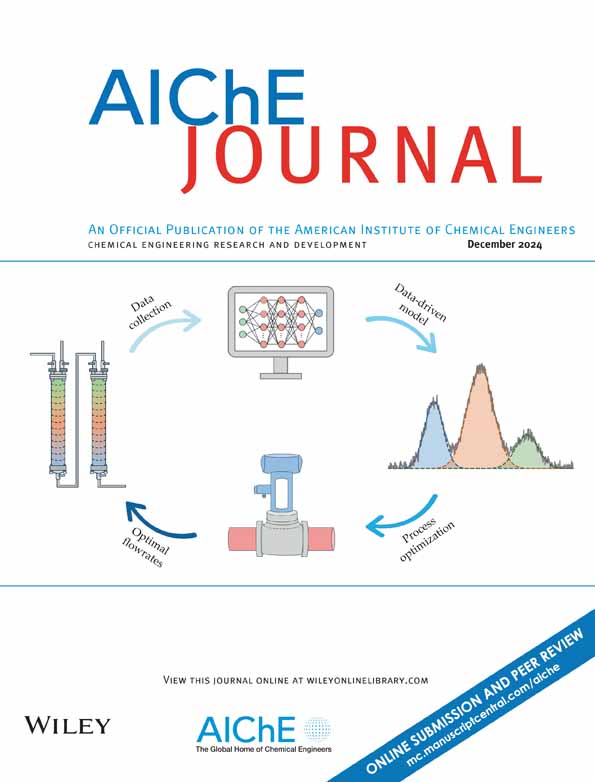自适应吸附剂中二支己烷异构体的分子筛选,用于辛烷值汽油生产的基准研究
IF 4
3区 工程技术
Q2 ENGINEERING, CHEMICAL
引用次数: 0
摘要
同分异构体的有效分离在各种工业应用中是至关重要的,特别是在生产高辛烷值(RON)汽油方面。本研究介绍了一种新型柔性吸附剂NCU‐542 ([Zn‐BTEC‐TEIB] [H4BTEC =邻苯二甲酸,TEIB = 1,2,4,5‐四(1H‐咪唑‐1‐基)苯]),具有自适应孔系统,可用于二支2,3‐二甲基丁烷(23DMB)和2,2‐二甲基丁烷(22DMB)异构体的分子筛选。NCU - 542独特的自适应框架选择性地吸附23DMB (RON = 101.7),同时排除22DMB (RON = 91.8)。因此,在23DMB/22DMB之间实现了创纪录的235.2 mg g - 1的吸附容量差异和73.3的吸收比。23DMB (1.03 × 10−3 s−1)的扩散时间常数(D′,D/r2)比22DMB (7.76 × 10−6 s−1)和基准刚性JNU‐2 (6.5 × 10−6 s−1)高130倍。此外,突破性实验表明,正己烷/2 -甲基戊烷/3 -甲基戊烷/23DMB/22DMB等摩尔混合物可生产基准RON值为99.2的优质汽油。在液体系统中,23DMB可以在环境条件下连续5次从23DMB/22DMB溶液中完全去除。本文章由计算机程序翻译,如有差异,请以英文原文为准。
Molecular sieving of di‐branched hexane isomers in a self‐adaptive adsorbent for benchmark research octane number gasoline production
Effective separation of isomers is critical in various industrial applications, particularly in the production of high research octane number (RON) gasoline. This study introduces a novel flexible adsorbent, NCU‐542 ([Zn‐BTEC‐TEIB] [H4 BTEC = pyromellitic acid, TEIB = 1,2,4,5‐tetra(1H ‐imidazol‐1‐yl)benzene]), featuring self‐adaptive pore systems for the molecular sieving of di‐branched 2,3‐dimethylbutane (23DMB) and 2,2‐dimethylbutane (22DMB) isomers. The unique self‐adaptive framework of NCU‐542 selectively adsorbs 23DMB (RON = 101.7) while excluding 22DMB (RON = 91.8). Consequently, a record‐high adsorption capacity difference of 235.2 mg g−1 and an uptake ratio of 73.3 are achieved between 23DMB/22DMB. The diffusional time constant (D ′, D /r 2 ) for 23DMB (1.03 × 10−3 s−1 ) is 130‐fold higher than that of 22DMB (7.76 × 10−6 s−1 ) and benchmark rigid JNU‐2 (6.5 × 10−6 s−1 ). Furthermore, breakthrough experiments demonstrate the production of premium gasoline with a benchmark RON value of 99.2 from the equimolar mixture of n ‐hexane/2‐methylpentane/3‐methylpentane/23DMB/22DMB. Within the liquid system, 23DMB can be completely removed from 23DMB/22DMB solutions for five consecutive cycles under ambient conditions.
求助全文
通过发布文献求助,成功后即可免费获取论文全文。
去求助
来源期刊

AIChE Journal
工程技术-工程:化工
CiteScore
7.10
自引率
10.80%
发文量
411
审稿时长
3.6 months
期刊介绍:
The AIChE Journal is the premier research monthly in chemical engineering and related fields. This peer-reviewed and broad-based journal reports on the most important and latest technological advances in core areas of chemical engineering as well as in other relevant engineering disciplines. To keep abreast with the progressive outlook of the profession, the Journal has been expanding the scope of its editorial contents to include such fast developing areas as biotechnology, electrochemical engineering, and environmental engineering.
The AIChE Journal is indeed the global communications vehicle for the world-renowned researchers to exchange top-notch research findings with one another. Subscribing to the AIChE Journal is like having immediate access to nine topical journals in the field.
Articles are categorized according to the following topical areas:
Biomolecular Engineering, Bioengineering, Biochemicals, Biofuels, and Food
Inorganic Materials: Synthesis and Processing
Particle Technology and Fluidization
Process Systems Engineering
Reaction Engineering, Kinetics and Catalysis
Separations: Materials, Devices and Processes
Soft Materials: Synthesis, Processing and Products
Thermodynamics and Molecular-Scale Phenomena
Transport Phenomena and Fluid Mechanics.
 求助内容:
求助内容: 应助结果提醒方式:
应助结果提醒方式:


